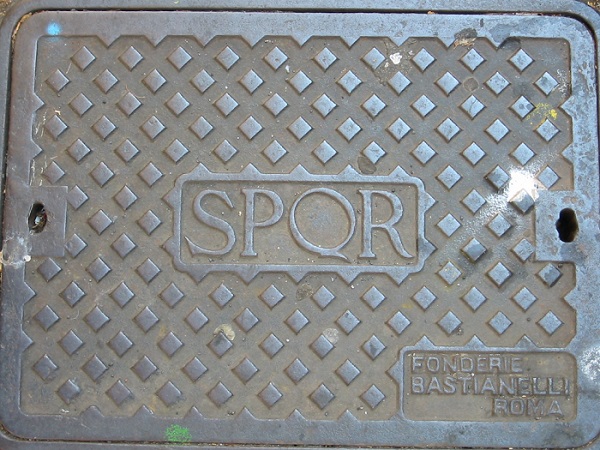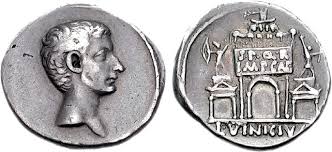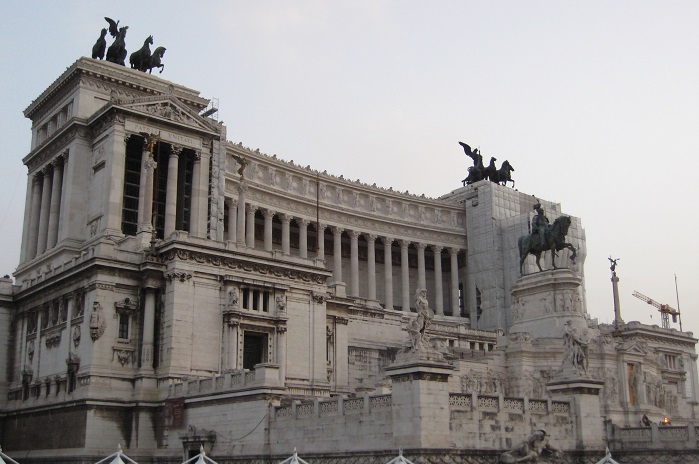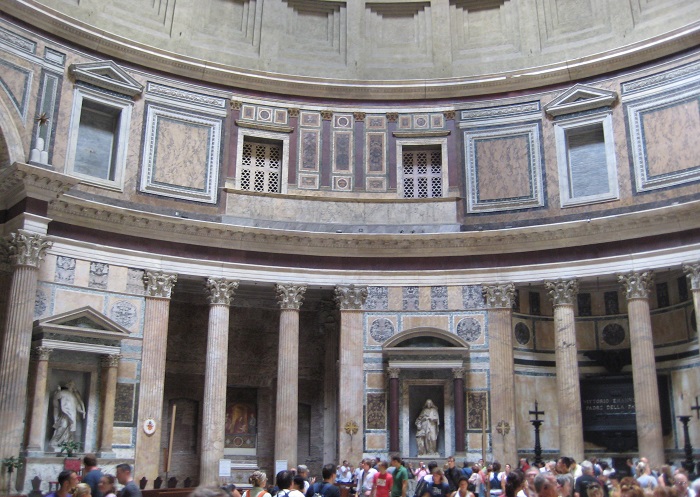
Your Italy virtual vacation continues as Thor and I ramble around Rome and ponder the evolving history and politics of the ancient abbreviation SPQR.
NOTE: Since travel is still on hold with the pandemic continuing, I’ve started a new blog series offering a virtual vacation and time-travel to my first big trip with Thor in 2008. Italy! Starting with highlight photos posted here on Saturday, Jan. 30, I’ll continue every week. Join us in Rome, Florence, Cinque Terre, Venice, and Milan. Buon viaggio!
As Thor and I continued our walks around the historic center of Rome, we couldn’t help noticing the metal “manhole” covers in the streets, bearing the familiar designation of SPQR. Images of those 50s-60s “sword and sandal” movies sprang to mind — Roman troops bearing banners and staffs with those letters. Doing a bit of research just now has taken me down a rabbit-hole, or rather manhole, of fascinating history.
Senatus Populusque Romanus — Senate and People of Rome — was an ancient Roman phrase that embraced the entire state and its two essential elements: Rome’s Senate and her people. The phrase or abbreviation appeared on altars and triumphal arches. Apparently the egalitarian nature of the phrase began to shift with the reign of Augustus Caesar, when he created coins with his image on the front, and a temple or triumphal arch with SPQR on the reverse side. Some historians suggest that the new emperor sought to solidify his authoritarian approach even as he pretended to continue the former Republic’s values and sharing of power with the people.

(Coin images from Wikimedia commons)
Historian Liv Yarrow notes that SPQR did not appear on coins during the earlier Republic, and the new coins with the abbreviation appeared as Augustus was trying to convince the citizens that he was working to restore the former glory of the Republic — “making Rome great again” — even as he was consolidating his absolute power. That tactic is all too familiar from Donald Trump’s continuing efforts to establish dictatorial power in the U.S. In fact, his advisor Steve Bannon followed the tactics of dictators such as Mussolini, who modeled himself after Augustus Caesar. When Mussolini exercised his Fascist rule in Italy during WWII, he set out to remake the image of Italy as a glorious empire harking back to the days of ancient Rome. He added the SPQR phrase and associated images such as the Roman eagle to public buildings, and encouraged a sense of Italian racial supremacy that allied with Hitler’s “racial-cleansing” program. Incidentally, Mussolini promoted the use of the manhole covers (is there a neutral-gender term?) with SPQR that are still used throughout Rome.
Medieval historian Carrie E. Benes describes the evolution of the phrase during the Middle Ages, as conveying a sense of authority and used even when logically it made no sense. Those using it included members of a Roman commune uprising, the Catholic Church, and Medieval Roman emperors (actually Germans).
Here’s the link to a fascinating online essay that gives more details of the evolving history and more information from the two historians mentioned above:
https://hyperallergic.com/457510/the-misuse-of-an-ancient-roman-acronym-by-white-nationalist-groups/
For most people, such as my tourist self, the letters are merely a curiosity and historical reminder. But I was surprised to learn that SPQR is now a symbol for white supremacists, including an Italian skinhead organization. Here, a new white-supremacist flag uses the abbreviation along with the Roman eagle:

(Flag image from Wikimedia commons)
In our rambles around Rome, Thor and I encountered another monument to national pride, “Il Vittoriano” — The Victor Emmanuel II National Monument. Built in the late 1800s, it honored the first king of a newly united Italy, and sought to echo the opulent style and power of the ancient Romans.

The grandiose monument — 200 feet high and 500 feet wide — features a 43-foot-long statue of the king on his high horse, and two Victory statues on quadringa chariots at the two top ends. Today the monument is regarded by many citizens as over the top, especially since an ancient neighborhood was razed to build it. Mussolini loved the monument and held parades and rallies in front of it. He added some of his own Fascist slogans and symbols such as the Roman eagle, which have since been removed. The current Italian government is apparently moving away from highlighting this monument to modern Roman (vain)glory.
As for SPQR, it seems that some Italians have a different translation of the abbreviation: “Sono Pazzi Questi Romani” (“They’re crazy, these Romans”).
On this lighter note, if you’d enjoy a fun flashback to those 50s and 60s sword and sandal movies featuring SPQR banners and staffs — which apparently were never actually used by the ancient Roman military — check out the hilarious and underrated Coen brothers film, “Hail Caesar.” It’s an affectionate spoof on the old Hollywood studio and movie star system, with George Clooney in a comedic mood as a vain star acting as a Roman centurion in a movie being filmed. Much mayhem occurs on and around several other movie sets as well, with star turns from Josh Brolin, Scarlet Johansson, Tilda Swinton, Channing Tatum (in a wonderful dance sequence channeling Gene Kelley), Ralph Fiennes, Alden Ehrenreich, Frances McDorman, and more. I may just go watch it again.
See you next week for more rambles around Rome, including the amazing ancient dome of the Pantheon!

*****
You will find The Rambling Writer’s blog posts here every Saturday. Sara’s latest novel from Book View Cafe is available in print and ebook: The Ariadne Connection. It’s a near-future thriller set in the Greek islands. “Technology triggers a deadly new plague. Can a healer find the cure?” The novel has received the Chanticleer Global Thriller Grand Prize and the Cygnus Award for Speculative Fiction. Sara has recently returned from another research trip in Greece and is back at work on the sequel, The Ariadne Disconnect. Sign up for her quarterly email newsletter at www.sarastamey.com

I see the white supremacist flag has the eagle clutching a bundle of fasces as well.
Anef, I just belatedly saw your comment. Yes, it’s disturbing.
-Sara